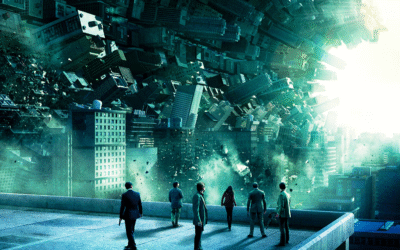The Mind in Solitude

Caves are inseparable from human imagination. When the Vanara army searches for Sita in the Ramayana, they are clueless and lost in the dense forest. Tired, thirsty, and hopeless, Hanuman sees some birds flying into a cave, which he infers is where water must be. The group enters a deep cave. Brightly illuminated, the cave is full of running streams, fruiting trees, and blooming flowers; it is encrusted with priceless jewels, mountains of gold and silver and platters stacked high with delectable roots and fruits. A female ascetic, Swayamprabha, has been meditating there for thousands of years. She uses her Yogic powers to help them reach the seashore. Her soul is freed from her mortal body (trapped in physicality) and ascends to a higher plane.
The ancients had a knack for embedding coded intelligence in the guise of folklore, rich in symbolism, which, though fanciful in appearance, carries more profound meaning. Here, the frustration of the monkeys led them to meditation (entering the cave) and intuition (the ascetic there is thoughtfully named Swayamprabha, which is the Sanskrit term for self-illumination). Jewels, gold, and silver symbolise past knowledge we carry in our DNA. Those who meditate know well about this treasure embedded in the perennial consciousness. It also keeps appearing in dreams, but we often ignore it as a fantasy.
I am blessed to have the friendship of Nagpur-based Santosh Pathakji, with whom I got acquainted through Dr Ashok Tiwariji, my long-standing friend. We started interacting when Santoshji shared information about a handwritten copy of the Ramcharitmanas, which a Brahmin Kripa Ramji wrote in Chitrakoot. He marked the date in the Samvat calendar, corresponding to May 21, 1838. It was a tradition in Brahmin families to write scriptures by hand for deeper study and veneration. It was preserved in the extended family for 187 years. Later, we often spoke on the phone and exchanged information on WhatsApp, which is the trend today. Pathak ji is an electrical engineer and senior to me. He worked for almost a lifetime with the Maharashtra State Electricity Board. I found an evolved soul in him and consider the material he shares a great blessing.
Recently, through Santosh ji, I learned about French geologist Michel Siffre (1939 –2024). He explored deep caves, a branch of geology called speleology. Unlike the recent trend of doing science by inference, confined to well-equipped laboratories and sustained within an echo chamber of conferences and journals, Siffre chose to be an explorer, spending time alone in deep underground cavities. He was fascinated by space explorers, who spent a long time alone. Of course, he must also have been curious to know why some hardened/heinous criminals were condemned to solitary confinement—the ultimate punishment that can be given to a human being. Indian scriptures emphasise meditation, which is, in essence, shutting out the external world by withdrawing the senses inward and exploring the inner world, which is imagined as vast and limitless as the Sky (chidakash).
After living in several caves, cut off from sunlight and carrying no watch for extended periods, Siffre decided to stay for six months in a 440-foot-deep cave in the southern Texas region of the United States. He made a simple scientific protocol and, without knowing it, shaped the field of human chronobiology. Siffre counted from 1 to 120, taking one pulse as one second. It took him five minutes to count to 120. In other words, Siffre was experiencing everything twice as slowly as on the surface of the Earth.
His mind failed to capture time without sunlight and a watch, and his memory was in disarray. It was like living one long day without sleeping. Sometimes, he would sleep for two hours and at other times, eighteen hours, but he couldn’t tell the difference. Siffre concluded that his body adjusted to a 48-hour rather than a 24-hour cycle without time cues. Instead of experiencing divine bliss or peace in consciousness, he developed a sense of overwhelming lethargy and bitterness in isolation. What is a man but a little tent with a flickering light under a vast, starry sky?
The absence of time can lead to a disorientation in consciousness. In most societies, time serves as a framework within which people live. Clocks govern everyday routines. However, when stripped of time, the mind loses the sense of the past, present, and future. This temporal dislocation can heighten awareness of the present moment, leading to a form of mindfulness. In solitude, individuals may be deeply immersed in the immediacy of experience—sounds, sights, and feelings become magnified as distractions fade. This heightened state of awareness can foster creativity, allowing for innovative thoughts and insights often overlooked in the busyness of life.
Conversely, the lack of temporal markers can initiate a psychological unravelling, as the mind may struggle to impose meaning without the structure that time provides. The human brain is wired to seek patterns and predict outcomes, and chaos may ensue without time as a guiding principle. Days may blur into one another, anxiety may heighten as uncertainty grows, and existential questions about meaning and purpose may surface. This confrontation with the self can lead to a profound sense of clarity or a descent into despair. The reactions are often influenced by individual temperament and prior experiences with solitude.
Moreover, solitude can amplify internal dialogues. In the utter darkness, one can see the vast imaginary world through one’s inner light. With fewer external distractions, the mind may begin to engage in extensive self-referential thinking—a process known as metacognition. The mind’s need for social interaction can provoke loneliness and isolation in solitude. This craving can manifest in heightened anxiety or a longing for reconnection, fundamentally altering one’s perception of identity and belonging. Experiencing an absence of this connection can lead to feelings of insignificance or a rediscovery of autonomy, where individuals, away from societal expectations, dive into the unconscious and embrace their thoughts and feelings. Sri Aurobindo writes in Savitri (Canto Five, lines 747-748):
The vague Inconscient’s dark and measureless cave
His only sunlight was his spirit’s flame.
Living in solitude without a sense of time can be both a transformative and tumultuous experience for the mind. The interplay between heightened awareness, emotional disorientation, and internal dialogue shapes a unique psychological landscape. Through this lens, one can see that solitude is not merely the absence of others but the presence of an opportunity to reflect, create, and ultimately redefine one’s relationship with the self. Embracing this process can lead to deeper self-understanding, an enhanced appreciation for life’s fleeting moments, and, potentially, a newfound clarity in navigating the complexities of modern existence. This truth is conveyed when Shri Krishna defines a Stithpragya (anchored in universal consciousness) as a person satisfied within himself – आत्मनि एव आत्मना तुष्टः स्थितप्रज्ञः तदा उच्यते (Shrimad Bhagavad Gita 2. 55). The immortal Self inside is our guide, and the Infinite Self outside is our goal. The handwritten Ramcharitmanas was a brilliant way to fill the solitude.
MORE FROM THE BLOG
The Theatre Within
I have been fascinated by Shakespeare, as most of those fancy English phrases and words that enchanted me were created by this one man who lived in England during 1564–1616. I was always intrigued by how one individual could produce such a great body of work that...
The Bhagavad Gita OS
In an era where our minds scroll faster than our hearts can feel, where information pours in like a relentless monsoon yet wisdom dries up like parched earth—the Bhagavad Gita stands not as an ancient relic, but as a future-ready operating system for the human spirit....
Yoga Vasishtha Walks into Nolan’s Dream
I watched Christopher Nolan’s Inception when it was released in 2010, back when going to the theatre still felt like an event. The film is centred around the idea of entering and manipulating dreams, slipping into layers of the mind as easily as walking through doors....




Sir your blog on the topic “The Mind in Solitude” is a deeply thoughtful reflection that beautifully captures the essence of inner stillness. Each words offer clarity and calm, encouraging readers to embrace solitude not as isolation, but as a powerful space for self-discovery and mental rejuvenation. A truly enriching read that inspires mindfulness in today’s noisy world. I love reading your blogs….
The feats of French geologist Michel Siffre, who spent 62 days underground in a cave in the French Alps and six months in solitude in Midnight Cave in Texas, may not seem impressive, as there has long been a tradition of spiritual seekers living alone in the Himalayas. Of course, he chose to go underground and cut himself off from sunlight, the source of life on planet Earth. No wonder his body rhythms were disrupted and his mind became confused. I understand the mind as a portal to access the Infinite. We grow by expanding our consciousness and not by locking it into a recursive mode of our little personal story.
This is a fascinating blog. Solitude gets a bad rap because it’s often equated with loneliness, but they’re not the same thing. Loneliness involves being isolated despite wanting social connections, whereas being alone means taking time for yourself between regular social interactions. You can be lonely even when in the presence of others, and you can also be alone without feeling lonely. Solitude can be beneficial when it’s voluntary and you feel good about spending time alone. However, it cannot be an escape from work or an avoidance of certain people. The science of solitude is well developed now. People live in smaller groups inside submarines and space stations.
Sir,
भूविज्ञानी मिशेल सिफ्रे की कहानी दिलचस्प है। उन्हें ध्यान की कला के बारे में पता नहीं था और इसलिए उनका मन भटक गया। ध्यान मन कोअराजकता की स्थिति से आनंद की स्थिति में ले जाने का कौशल है जिससे मन को कम समय में शांत किया जा सकता है। 15-20 मिनट में आपगहन विश्राम का अनुभव कर सकते हैं, जो सबसे गहरे विश्राम से भी अधिक गहरा होता है। ध्यान वह अवस्था है जहाँ से सब कुछ आया है और जहाँसब कुछ जाता है। यह आंतरिक शांति है जहाँ आप आनंद, खुशी और शांति महसूस करते हैं।
Arun Ji, Extremely thought-provoking Blog ! Thank you for expressing so beautifully.
This reflection stirred something profound within me. It reminded me that caves are not just physical spaces, but symbols of the inner world we often avoid entering.
Siffre’s journey into the heart of the earth mirrors what the ancients practised through meditation — going inward to face the unknown. Without the clock or sun, we see how much we rely on the external to define our inner state. And yet, it is in that very disorientation that a new awareness can arise.
I was especially moved by the idea that our inner light is enough. Perhaps in today’s world, solitude is not punishment, but a sacred invitation — to listen, see, and remember who we are beneath all our roles.
Thank you for this soul-touching piece. It doesn’t inform but transforms !! May we treasure solitude and be blessed!
Solitude is crucial for spiritual growth, offering a space for introspection, self-discovery, and connection with one’s inner self and a higher power. It allows for processing emotions, healing from hurts and disappointments, and developing a deeper understanding of oneself and one’s place in the world. I can say from my personal experience that regular short spells of solitude can provide a fresh perspective on life’s challenges and opportunities, leading to a renewed sense of purpose and direction. Thank you for sharing Sir.
Many saints have experienced God as Inner Light. When we meditate and see the light at the point between the eyebrows, we see Him as light. Calling on God as light is one way we can connect to God through meditation. I have spent time meditating intently and with deep devotion at the point between the eyebrows and could see the white light. Solitude is not a problem for the spiritually evolved, as I see it.
The Ramayana’s portrayal of Hanuman and the Vanara army, searching for Sita in the dense forest, subtly mirrors a deeper journey into the self, where external struggles lead to inner revelation. The symbolism of entering a cave and encountering Swayamprabha, the ascetic, reflects the power of introspection and meditation, which reveals hidden wisdom and knowledge, much like the jewels, fruits, and streams in the cave. The stories we inherit aren’t just fanciful narratives but contain layers of understanding that become apparent when we look deeply. The example of Swayamprabha’s name, “self-illumination,” points to the potential of inner wisdom awaiting discovery through conscious reflection and meditation. The idea that solitude, especially without the structure of time, can serve as a tool for deep self-reflection is powerful. The blog beautifully intertwines myth, science, and philosophy, inviting us to contemplate the role of time, solitude, and meditation in our own lives.
About Ramcharitmanas: The Valmiki Ramayana is a smriti text (Etymology) from the ancient Indian epics of Treta Yuga*, which are also known as Itihasa (History).
Later in the 16th century, Goswami Tulsidas (a great poet and devotee of Rama, the seventh avatar manifestation of God Vishnu) authored Ramcharitmanas in Awadhi ( a dialect of Eastern Hindi) with many inspirations from Valmiki Ramayana. Ramcharitmanas is regarded as a revered Hindu scripture from which, not to mention the least, the Indian civilisation takes its charm.
* Treta Yuga: In Hindu cosmology, it is the second of the four Yugas (ages) in a cyclical time cycle known as the Maha Yuga. It lasts for 1296,000 years.
Dear Sir, Thank you for such a profound and beautifully interwoven reflection. I was particularly moved by how ancient symbolism, personal anecdotes, and scientific exploration came together seamlessly. The juxtaposition of Swayamprabha’s inner illumination with Michel Siffre’s outer isolation was compelling—it reminded me that solitude can either enlighten or disorient, depending on how we engage with it. This piece made me pause and reconsider my relationship with time, silence, and self-awareness. Grateful for the inspiration and wisdom in your writing, sir. Warm Regards,
I’m not “educated” in the thoughts of abstractness but your blog opens the window to peep and learn on those lines!
Excellent narration of your experiences. Ma Saraswati is simply flowing in your pen!
Good blog.
Yes, solitary confinement is a punishment – but is not solitude in real sense as it is imposed.
The outcome of a solitude should not be confused with disorientation.
Voluntary confinement (solitude) helps one in concentrating, comprehending the happenings and paves way for a path towards a eluding solution (for materialistic problems).
Solitude has helped me overcome materialistic problems.
I hope in the days to come, it will help me in achieving the much needed detachment to earthly problems.
Best wishes to all.
A spiritual guide is required to detachment.
Great reflection Prof Tiwari Ji
Dear Arunji, A truly insightful piece—beautifully blending mythology, science, and spirituality. The parallel between Hanuman’s symbolic cave and Siffre’s real descent into solitude is striking. It reminds us that both outer exploration and inner stillness can reveal profound truths. Thank you for sharing such rich reflections and rare treasures like the handwritten Ramcharitmanas.
Living in solitude is interesting, though I don’t agree totally with it.
Thank you for the intriguing piece on the state of the mind in solitude.
I guess the punishment of solitary confinement is bad enough to emphasize your point: humans are social beings with interactions shaping our lives positively. We should condemn forced solitary confinement as being cruel.
Voluntary solitude, on the other hand, as a means to meditate and improve oneself from a divine perspective, is beneficial.
This write-up beautifully connects stories from ancient times with modern science and human psychology. It shows how cave, both real and symbolic, can lead us to deep understanding. The cave, whether in the forest or in the mind, is a gateway to self-discovery. Solitude is not a void but a sacred space where time dissolves and the soul speaks. Like Hanuman in search of Sita or Siffre in pursuit of knowledge, the real journey is always inward. In stillness, we find light, not from the sun, but from within.